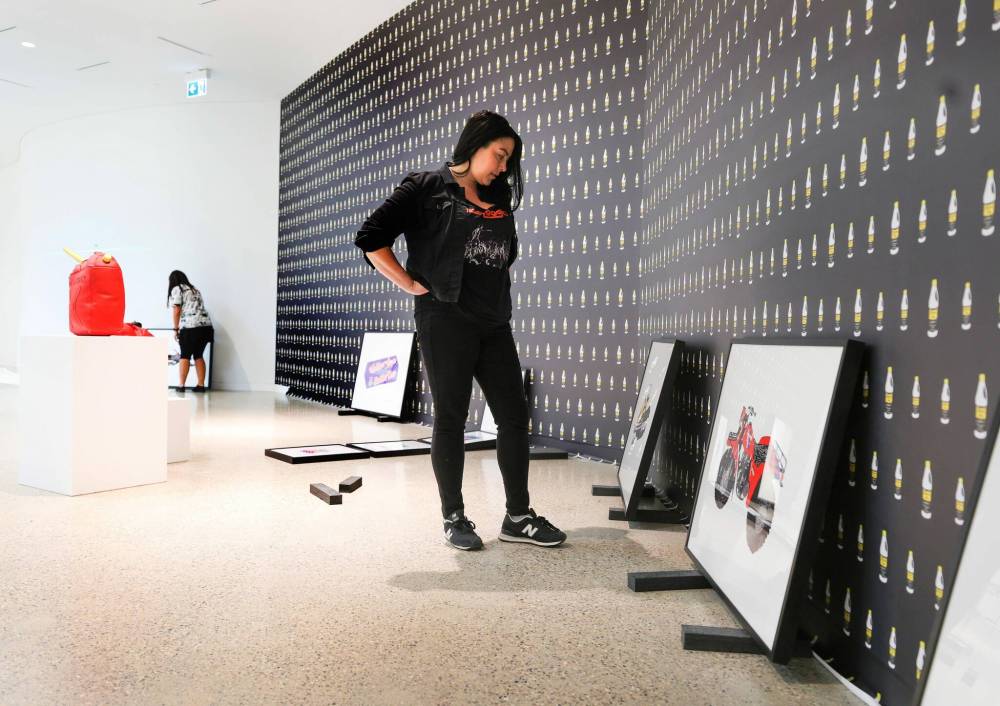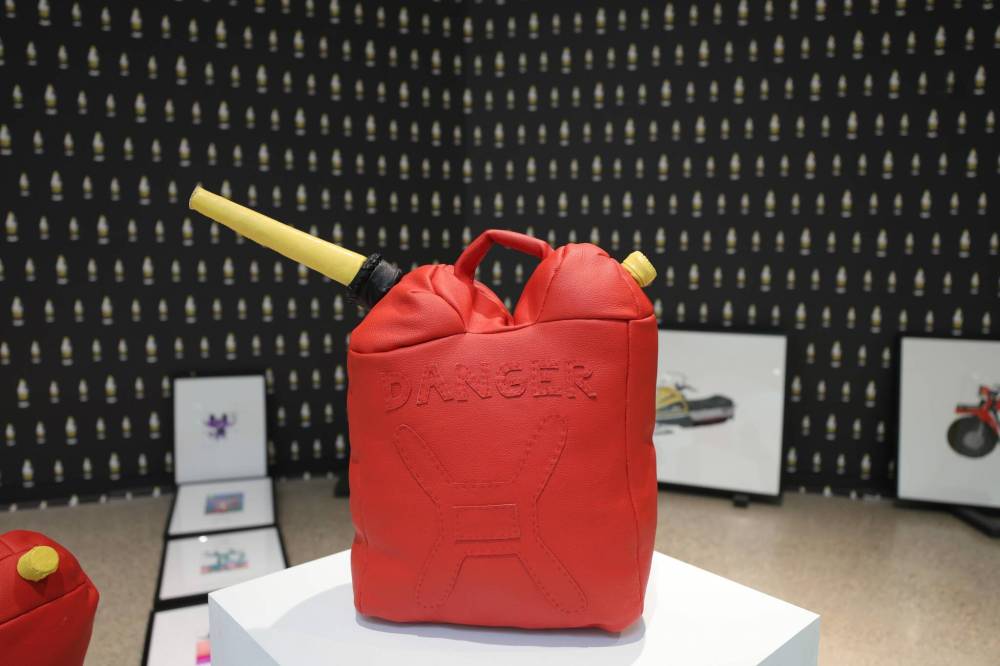Fuelled by memories Inuit artist Tarralik Duffy’s WAG-Qaumajuq exhibition inspired by growing up in Nunavut
Read this article for free:
or
Already have an account? Log in here »
To continue reading, please subscribe:
Monthly Digital Subscription
$1 per week for 24 weeks*
- Enjoy unlimited reading on winnipegfreepress.com
- Read the E-Edition, our digital replica newspaper
- Access News Break, our award-winning app
- Play interactive puzzles
*Billed as $4.00 plus GST every four weeks. After 24 weeks, price increases to the regular rate of $19.00 plus GST every four weeks. Offer available to new and qualified returning subscribers only. Cancel any time.
Monthly Digital Subscription
$4.75/week*
- Enjoy unlimited reading on winnipegfreepress.com
- Read the E-Edition, our digital replica newspaper
- Access News Break, our award-winning app
- Play interactive puzzles
*Billed as $19 plus GST every four weeks. Cancel any time.
To continue reading, please subscribe:
Add Winnipeg Free Press access to your Brandon Sun subscription for only
$1 for the first 4 weeks*
*$1 will be added to your next bill. After your 4 weeks access is complete your rate will increase by $0.00 a X percent off the regular rate.
Read unlimited articles for free today:
or
Already have an account? Log in here »
Hey there, time traveller!
This article was published 21/09/2023 (740 days ago), so information in it may no longer be current.
Tarralik Duffy is adjusting the nozzle on a jerry can she has sewn from Barbie-pink leather, bold Inuktitut syllabics on its front. It’s not quite sitting right.
The multimedia artist, jewelry maker and writer is putting the finishing touches on her solo exhibition, Gasoline Rainbows, which opens today at WAG-Qaumajuq. She’s intimidatingly cool in her all-black outfit — Stooges T-shirt and black denim, long black hair swept up into a black velvet scrunchie — but she’s also one of those warm, funny people who immediately makes you feel as though you’re a lifelong friend.
She leans in conspiratorially to show off the faint bruise colouring her cheek, an injury sustained in a last-minute sewing accident.
“I was pulling so hard on my needle I punched myself in the face,” she says.
RUTH BONNEVILLE / WINNIPEG FREE PRESS Multimedia artist Tarralik Duffy puts the finishing touches on her solo exhibition, Gasoline Rainbows, which opens today at WAG-Qaumajuq.
Through her soft sculptures and drawings, Duffy turns the everyday objects that loomed large in her childhood memories of growing up in Salliq (Coral Harbour), Nunavut into bold, playful pop art.
As one might expect in a show named for that beautiful and toxic skim of iridescence on a pool of gasoline, jerry cans figure prominently.
“Jerry cans are very specific to a memory that’s tied to going out on the land,” says Duffy, who is now based in Saskatoon. “Like, now we’re gonna go fishing, or we’re gonna go camping. And when I was growing up, we always left in these huge caravans of Ski-Doos and qamutiiks, with jerry cans tied to the back. It’s very nostalgic in that sense.”
“When I was growing up, we always left in these huge caravans of Ski-Doos and qamutiiks, with jerry cans tied to the back. It’s very nostalgic in that sense.”–Tarralik Duffy
Gasoline Rainbows is the culmination of Duffy’s four-week residency at WAG-Qaumajuq, which she received as the winner of the 2021 Kenojuak Ashevak Memorial Award (KAMA), a biennial prize organized by the Inuit Art Foundation that celebrates and supports the work of mid-career Inuit artists. In addition to the artist-in-residency program and the solo exhibition, winners receive $20,000 and the gallery will acquire an artwork from the artist for its permanent collection.
“KAMA happened during COVID, so it was like a fever dream, a little bit,” Duffy says.
Like so many things during that time, her career high had to happen over Zoom.
“We did the award and I was very emotional. And then I just closed my computer and you’re alone again. I spent a lot of time alone while creating, so even that big celebration was kind of connected but also disconnected. It was a mixed bag of emotions,” she says.
RUTH BONNEVILLE / WINNIPEG FREE PRESS Gasoline Rainbows is on until March 17, 2024.
Being in Winnipeg for her residency also stirred up homesickness.
“Honestly, the hardest part of the residency was being this close to home without being able to fly home because Winnipeg is always, to me, the gateway to Nunavut — specifically Coral Harbour, my home. So that was really hard, even though it was like the best thing in my life happening as far as career and being able to work on my art, but that’s definitely been playing on my mind and heart, pulling on me,” she says.
And so, she put her home into her work.
Tarralik Duffy has a Manitoba birth certificate; she was born in Churchill in 1979. She likes her age, 44. She likes symmetry and repetition, as evidenced by her Warholian prints of Red Rose tea boxes and Coleman stoves, or her China Lily soy sauce bottles, which now wallpaper an entire gallery wall in black and gold.
“It’s so pervasive in Nunavut — if you’re going to the store, any store shelf, you see the Great Wall of China Lily,” she says. “But it’s also one of the most nostalgic food items for me because my favourite food growing up was tuktu quaq, raw frozen caribou. And we always had that dipped in China Lily. It was just always on my grandmother’s table, or my mom’s table. It’s just something you see everywhere.”
RUTH BONNEVILLE / WINNIPEG FREE PRESS Gasoline Rainbows is the culmination of Tarralik Duffy’s four-week residency at WAG-Qaumajuq, which she received as the winner of the 2021 Kenojuak Ashevak Memorial Award.
Duffy creates her own iconography out of the familiar labels we see every day, but her work is not all warm-fuzzy nostalgia; there’s something menacing about the ubiquity of those products, housed in their forever plastics, too.
“There’s something that’s so permanent about southern packaging. Everything that we had as Inuit in the past would just go back to the earth. And then these things have a permanence that is dangerous — as dangerous as the fuel in the can,” she says.
“I think about that, too, because we used animals for fuel, and it was a gentler footprint left behind. Now, everything that comes from the south is wrapped in garbage. And it just becomes garbage. And then it’s something you just see all the time, when it’s new and when it’s old.”
Her art is often driven by urgency — “I want it to be alive, like, this idea has to happen now” — as was the case with the digital drawing Blubber Yum, a bright purple and pink Hubba Bubba-esque bubblegum package with the contents reimagined: “hard’n chewy, real mataaq taste.”
“That’s one of my favourite pieces,” she says.
Duffy had a piece of baby-pink leather that reminded her of blubber, which in turn reminded her of a time she was hanging out with her auntie.
“We were eating tuktu quaq with the tunuq, which is the caribou butt fat and she said that it was so delicious she could just eat it like a delicious piece of bubblegum, and I remember we just laughed. The memory had just come to me and suddenly I was like, ‘Oh, Blubber Yum.’ I think that’s why I like it, because it was just this inspired thing.”
It also got her thinking about the power of branding.
“What if our food was wrapped in pretty packaging? Would people look at it differently?”
RUTH BONNEVILLE / WINNIPEG FREE PRESS Through her soft sculpture and drawings, Duffy turns the everyday objects that loomed large in her childhood memories of growing up in Salliq (Coral Harbour), Nunavut into bold, playful pop art.
She points to Blubber Yum’s reference to mataaq or muktuk, whale blubber and skin cut into cubes, as an example.
“There are people still, to this day, that think it’s so barbaric, and yet, their food is wrapped in plastic and it’s choking the world,” she says.
Gasoline Rainbows doesn’t just contain scenes of home, it also includes the fingerprints of Duffy’s family. As it happens, the WAG-Qaumajuq had a 1970s piece by her mother, Leonie N. Duffy, called Personal Adornment, a wall hanging made from felt and embroidery thread on wool duffle.
And Duffy’s eight-year-old son Anguti — who is playing on a laptop nearby in the gallery while his mom works — also has an untitled piece in the show from his 2023 felt-pen-on-paper series Croco Smile.
“What I love about his approach, which is very free, is he could just sit there and just pump out drawings,” she says fondly. “So joyous, you know? No critical mind involved. I find that very inspiring.”
Gasoline Rainbows is on view until March 17, 2024.
jen.zoratti@winnipegfreepress.com

Jen Zoratti is a columnist and feature writer working in the Arts & Life department, as well as the author of the weekly newsletter NEXT. A National Newspaper Award finalist for arts and entertainment writing, Jen is a graduate of the Creative Communications program at RRC Polytech and was a music writer before joining the Free Press in 2013. Read more about Jen.
Every piece of reporting Jen produces is reviewed by an editing team before it is posted online or published in print – part of the Free Press‘s tradition, since 1872, of producing reliable independent journalism. Read more about Free Press’s history and mandate, and learn how our newsroom operates.
Our newsroom depends on a growing audience of readers to power our journalism. If you are not a paid reader, please consider becoming a subscriber.
Our newsroom depends on its audience of readers to power our journalism. Thank you for your support.
